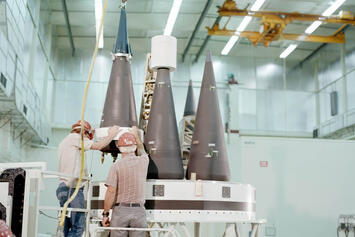
As recent events in Iran have so aptly demonstrated, technological progress married to industrial might produces the most tangible form of power. In the recent conflict in the Middle East, this meant that a second-tier power like Iran was clearly outmatched – first by Israel, then by America.
The West needs to learn this lesson and apply it to its rivalry with a far more formidable foe: China. Unlike the theocrats of Tehran, China’s ambitions are distinctly material. And, until recently, China has made tremendous headway facing relatively little, and largely ineffective, Western opposition.
Fortunately, in America at least, there is an emerging industrial renaissance, led by a wave of new firms investing in key technologies, such as drones, satellites, fuel-efficient jet engines and robotic drilling. These and similar companies remain the West’s best hope of slowing China’s bid for global pre-eminence – a campaign that now extends into space and advanced military systems.
China, the most important ally of Tehran’s beleaguered mullahs, cannot be easily dismissed. Since its accession to the World Trade Organisation in 2000, China has grown to the point where it boasts as many factory exports as the US, Japan and Germany combined. In 2023, the Middle Kingdom forged roughly half the world’s steel and became the world’s largest automobile market – including for electric vehicles, whose batteries are linked to an industrial economy that’s highly dependent on coal-burning power stations. It also accounts for more than half of all shipbuilding.
The impact has been devastating on the West. Europe’s industrial sector continues to decline, shedding one million manufacturing jobs between 2019 and 2023. In the US, a study by the Economic Policy Institute found that China’s export surge alone cost up to 3.7million American jobs since 2000. Between 2004 and 2017, America’s share of global manufacturing fell from 15 per cent to 10 per cent, even as its reliance on Chinese inputs doubled, while those from Japan’s and Germany’s fell.
Unlike Japan in the 1980s, whose growth threatened American industries, China’s rise is directly tied to power projection, with substantial investment in space, robotics and other technologies with military uses. By contrast, the US struggles to supply its own forces – and those of its closest allies – with basic ammunition. Until recently, it has even relied on China-based industry to produce key parts in areas as sensitive as submarine production.
Without a full-scale industrial revival, the West risks following the disastrous path of Nazi Germany, Imperial Japan and the Soviet Union – all of which were ultimately overwhelmed by superior industrial and technological power.
Read the rest of this piece at: Spiked.
Joel Kotkin is the author of The Coming of Neo-Feudalism: A Warning to the Global Middle Class. He is the Roger Hobbs Presidential Fellow in Urban Futures at Chapman University and and directs the Center for Demographics and Policy there. He is Senior Research Fellow at the Civitas Institute at the University of Texas in Austin. Learn more at joelkotkin.com and follow him on Twitter @joelkotkin.
Photo credit: Picryl.












